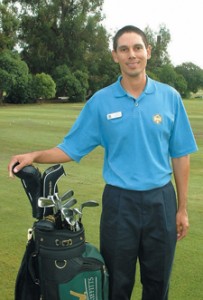INSTRUCTION
A Hard Lesson to Learn
If you want to hit the ball better and improve your rhythm, just take it easy.
By O. J. Amaya, PGA Published: February, 2005 – Southland Golf Magazine

Patient: Female
Age: 36
Current Handicap: 24
Lowest Handicap: 24
Has played golf for: One year
Plays: About twice a month
Practices: About twice a month
The symptoms: I’m extremely competitive and I’ve been involved in sports my whole life, but I’m new to golf. In other sports or in the gym, if I want to get a little more out of myself I just work a little harder or get more aggressive, but this doesn’t work in golf. The harder I try to hit the ball, the worse the result. What are some things I can think about when I want to hit the ball harder?
Dr. Golf’s prescription: The golf swing is a series of events that, when performed correctly and in sequence, produces long and straight shots. Typically, when a golfer attempts to hit the ball harder, the proper sequence is thrown out of kilter and a poor shot results.
There are two keys to prevent this from happening. Stay on the correct swing plane throughout your swing and keep your left wrist flat during the entire motion. Practice this without hitting balls and swing slowly to monitor your positions. When you feel comfortable, grab a bucket of balls and put your new form and rhythm to the test. Hopefully, you’ll see better results.
Patient: Male
Age: 44
Current Handicap: 15
Lowest Handicap: 13
Has played golf for: 15 years
Plays: Once or twice a month
Practices: Occasionally warms up
The symptoms: My short game stinks. I waste probably four or five shots a round with poorly hit chips and pitches around the green. I notice other players using different clubs around the green, but I’ve only used a sand wedge. Is there some rule for when to use the other clubs in your bag, and what is the benefit of using different clubs around the green?
Dr. Golf’s prescription: Using a sand wedge exclusively around the greens is a common mistake of amateurs. Many tour players only use a wedge for their short shots, but keep in mind that they spend hours and hours perfecting this technique.
A good rule of thumb is minimum air time and maximum ground time. Get your ball on the putting surface as quickly as possible and let it roll to the hole. When the terrain allows, use a 5, 6, 7, 8 or 9 iron to chip with. The key is to select a club that will get your ball over the long grass between you and the green and make sure there is enough green to let the ball run out. The more like a putt you can make your shot, the better off you’ll be.
O.J. Amaya is a PGA teaching professional Eastlake Country Club in Chula Vista, CA. He can be reached at (619) 846-9978. These prescriptions are meant as short-term solutions. To make real improvements in your game, see you local PGA professional. Patients in need of help from Dr. Golf should send their ailments to scpgamedia@aol.com.
